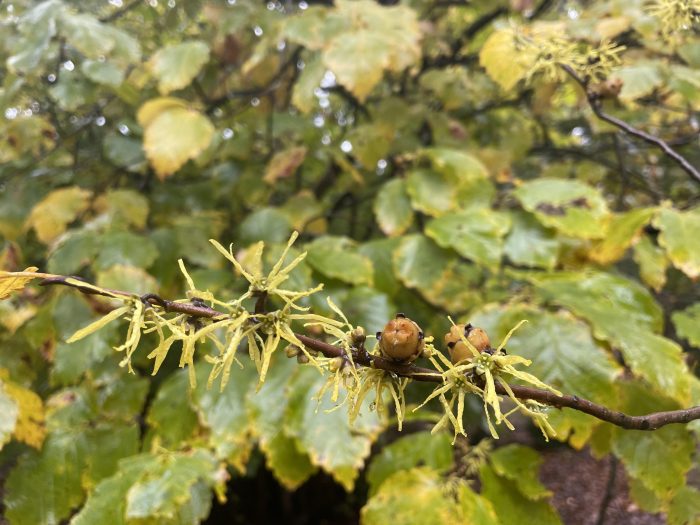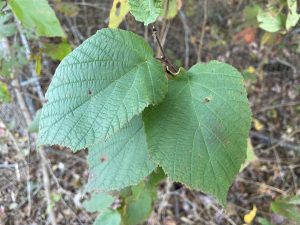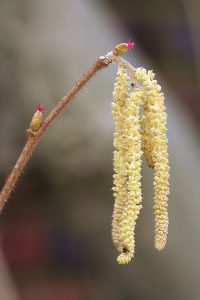Nature Matters: The ‘Hazels’—Witch Hazel and American Hazelnut

By John L. Turner

As the cooler days and nights of autumn take hold, the abundance of flowers diminishes with goldenrod and aster blossoms soon dominating the scene beginning in late August and blooming well into October. One might reasonably think that by the time Halloween comes around the year’s predictable procession of wildflowers, flowering shrubs, and trees has run its course.
But while you’re making decisions as to what costume to wear for Halloween, there’s one more wildflower-producing plant to entice pollinating insects before the full cold of winter descends. That wild plant is a shrub, witch hazel (Hamamelis virginiana), which sometimes blooms after it has dropped its leaves.
Widespread but uncommon throughout Long Island, witch hazel is a bit more common in the richer soils occurring in the northern half of Long Island where it grows as a multi-stemmed tall shrub or low stature tree. Witch hazel is scattered throughout the understory of the forest with groupings of plants; I know of no site where the species is abundant, although there are quite a few specimens growing on top of the wooded slope adjacent to Wading River marsh in the large Shoreham property that may soon become Long Island’s next large public space.
It’s also fairly common in the morainal region of the South Fork. The famous naturalist from Orient, Roy Latham, reported in 1926 a witch hazel from Montauk with a six inch diameter. A very large, multi-stemmed specimen, accompanied by an informational sign, is in full view just north of the dirt parking lot at Prosser Pines County Park situated in Middle Island (on the east side of County Route 21).

Why the very late blooming season for witch hazel? We’re not sure but it may follow the strategy used by skunk cabbage in the Spring, that is, blooming at a time when plant competition for insect pollinators is reduced, thereby increasing the likelihood of reproductive success. The flowers are visited by wasps, gnats, and several types of flies. As insurance against a lack of pollinators due to early cold, the flowers can self-pollinate.
Speaking of flowers, those of witch hazel are distinct and not likely to be confused with any other species. Growing on small branches below the leaves, the flowers are straw-yellow in color and have four narrow but long, ribbonlike petals that give the flowers the appearance of windblown confetti. There are several horticultural cultivars available, some of which have been developed adorned with bright orange petals.
If you look closely you’ll see the flowers in close proximity to the woody capsules containing the seeds — last year’s flowers that were successfully pollinated having formed seeds. In the fall the seeds are forcefully ejected from the capsule and, remarkably, can travel 25 feet or more, leading to another colloquial name: snapping alder. It is uncommon for flowers and the product of last year’s flowers — seeds — to be on a plant at the same time. This trait of witch hazel gives rise to the plant’s generic name Hamamelis, a Greek word meaning “fruit at the same time.”
The leaves are as distinctive as the flowers. The medium-sized leaves have scalloped, roundly toothed edges and prominent parallel veins that extend to the edge. Most notably, and for reasons unknown, the leaves are asymmetrical in that the base of the leaves attach at slightly different points along the main stem, or as one famous botanist noted, the leaves are: “inequilateral at the broadly rounded or subordinate base”.
Witch hazel liniment, used for skin inflammation or irritation, is derived from the plant’s bark and twigs. Through the years the liniment, still available over-the-counter at local drug stores, has been touted as a cure for a bunch of health ailments including sore throats, rheumatism, insect bites, bruises, scrapes, burns, even “frozen limbs, lame back, and bleeding lungs.”
Witch hazel has another magical property: use in divining rods to pinpoint water through the process of “water witching.” Indeed, the “witch” in witch hazel has nothing to do with human witches but is a derivation of the Anglo-Saxon word “wych” or “wicen” meaning “to bend,” a reference to the use of pliable witch hazel branches as divining rods.

American hazelnut (Corylus americana), a member of the Birch family, is not known to be used as a soothing liniment like witch hazel, but does share a history with the species as its branches are a tool in “water witching.” And like its commercially important European cousin, European hazelnut or filbert (which are twice as large), its nuts have value as a wildlife food. They are eaten by turkeys, quail, blue jays, pheasants, chipmunks, squirrels, white-footed mice and several other bird and mammal species.
As suggested by the number of animals that eat them, the nuts are a superfood of sorts: they contain 25% protein and 60% fat, a high calorie food item wildlife love. The nuts don’t look like nuts when on the shrub since they are enveloped in a covering that looks like torn clothing. Deer, rabbits and not on Long Island — beavers browse upon the branches and twigs.
The species is smaller than witch hazel, being a medium-sized shrub, often forming thickets, a habit which makes it valuable to nesting songbirds. Like witch hazel it is uncommon on Long Island but widespread. I have seen it in a number of locations including a population growing on the east side of the Long Island Greenbelt Trail in northern Islip Town.
The leaves are pretty, being pointy and heart-shaped and are much larger than witch hazel’s. But unlike witch hazel’s flowers which, as previously mentioned are insect pollinated, the small, almost inconspicuous reddish female flowers of hazelnut are pollinated by the wind. They bloom in April. The male flowers, in the form of long, cigar-like catkins are more prominent. These are consumed by several species of game birds like ruffed grouse (feared to have been extirpated from Long Island).
I hope you make the acquaintance of both species, starting with Witch Hazel, perhaps on a trip to Prossers Pines County Park to walk off the extra Halloween candy you indulged in. Just watch out for those exploding witch hazel seeds!
A resident of Setauket, John Turner is conservation chair of the Four Harbors Audubon Society, author of “Exploring the Other Island: A Seasonal Nature Guide to Long Island” and president of Alula Birding & Natural History Tours.






